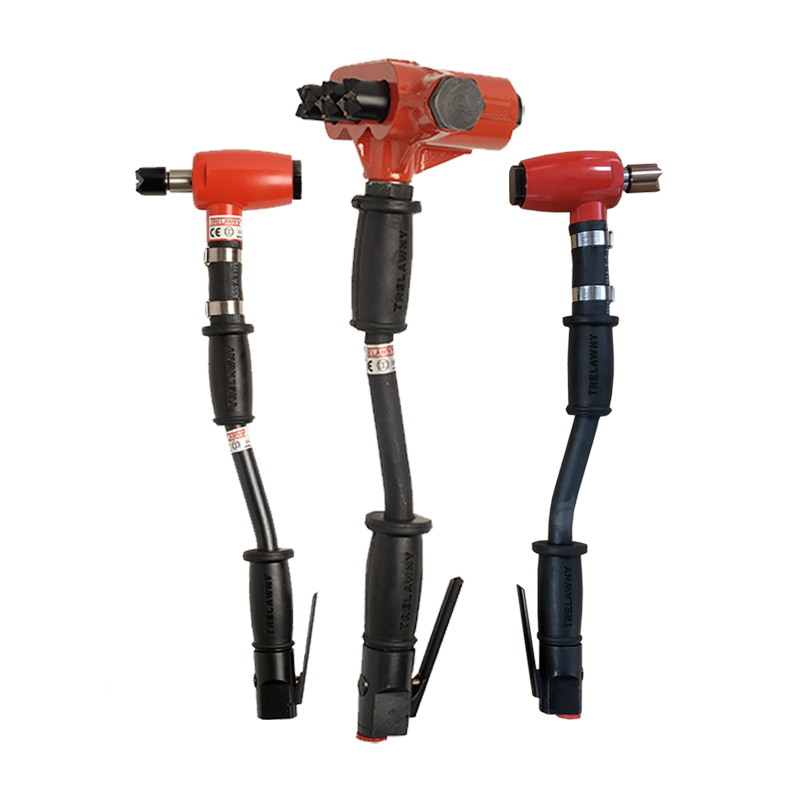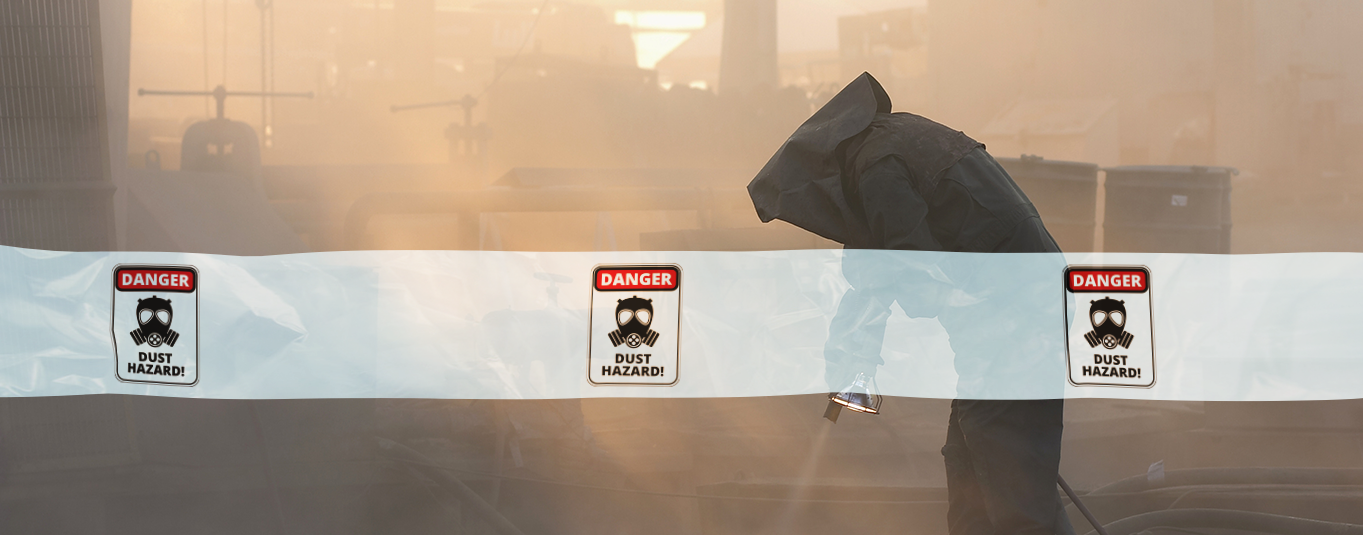This discussion paper aims to help inspectors, safety and environmental professionals understand the requirements of the newly reduced silica limits, and what it means to abrasive blasting operations
What is crystalline silica?
Silica is silicon dioxide, a natural, widely abundant mineral that forms a major component of most rocks, sands, and soils. There are noncrystalline and crystalline forms of silicon dioxide. The most common type of crystalline silica is quartz. The amount varies widely amongst different rocks, rock products, and can be found in aggregates like mortar, concrete, and mineral sands.
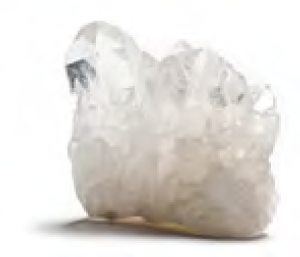
Free Crystalline silica and effects on health
When workers inhale the free crystalline silica, the lung tissue reacts by developing fibrotic nodules and scarring around the trapped silica particles. This fibrotic condition of the lung is called silicosis. When the nodules grow too large, breathing becomes difficult, and it may result in death. Silicosis victims are also at high risk of developing other chronic diseases such as lung cancer, chronic bronchitis, tuberculosis, etc.
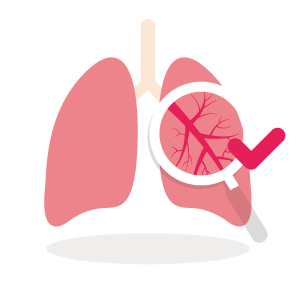
Free crystalline silica and garnet
Not all garnets are the same. The quality levels of garnet depend on the deposit, mining, and processing controls in place.
GMA’s concentrate in Australia is derived from older rock deposits that have been through millions of years of prolonged attrition to become solid almandine garnet particles. Through GMA’s world-class mining and processing procedures, the free quartz and other waste materials are virtually removed. Rigorous testing is conducted multiple times a day to ensure high garnet purity and concentration levels. Independent third party tests are also conducted regularly to determine low levels of free crystalline silica and test reports are readily available upon customer’s request. GMA’s free crystalline silica results come well under the minimum threshold of 1% of weight by volume (usually under 0.1%), unlike other garnet suppliers. (Refer to a chart compiled from independent laboratory test reports below).
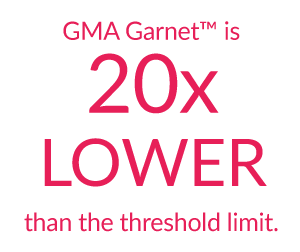
Tip: Request independent test reports following as close to the Standard AS4350.2-1999 for HLS determination.
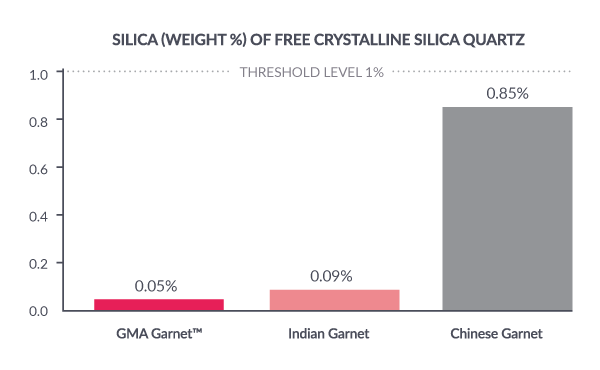
The new silica limit
Background
A health-based review of the current scientific evidence for silica dust showed that the Workplace Exposure Standard (WES) should be reduced to prevent adverse health effects (i.e. silicosis and lung cancer) in workers.
The proliferation of synthetic stone tops has led to a spike in healthrelated cases and silica dust exposure. The synthetic material has a higher concentration of dangerous particles compared to natural stones like marble.
Recently, the Australian government has tightened its controls, aiming to reduce 30% of serious silica dust related serious injuries and illnesses by 2022².
Free crystalline silica – Concentration in the bag and the air
What’s in the bag
The Standards state that:
1. Materials with more than 1% free crystalline silica should not be used for abrasive blasting.
GMA takes reference from ISO 11126-10:2017, SSPC-AB1 (NIOSH Method 7500)3 that outlines the latest free crystalline silica limits.
What’s in the air
2. Respirable crystalline silica (silica dust) limits have changed from 0.1 mg/m3 to 0.05 mg/m3.4
The 0.05 mg/m3 free crystalline silica limit states the concentration of an airborne hazardous chemical (e.g. respirable crystalline silica) within a worker’s breathing zone should not cause adverse health effects or undue harm. Compliance with the WES is required under the Commonwealth, state and territory Work Health and Safety (WHS) laws.
This means that workers should not be exposed to more than 0.05mg/m3 silica dust over an eight-hour working day (i.e. time weighted average) for a five day work week.
It is important to check in with your local WHS regulator to see if they have introduced any new regulations for silica dust in addition to reducing the WES5.

587,000
Australian workers were exposed to silica dust in the workplace in 2011.*
SiO₂ (Quartz and Free Crystalline Silica)
Reporting in Product Documentation
The “Average Chemical Composition” presented in the Product Data Sheet (PDS) provides the chemical arrangement, type and molecules that make up the garnet. This is the actual chemical elements that make up the garnet grain. This is a common method of reporting the composition of sand, rock and soil samples. It is important to note that the chemical composition does not represent the physical composition of the product. The relative proportion of SiO₂ reported in the “Average Chemical Composition” table does not represent physical grains of ‘silica sand’ or free silica dust. Rather, the relative proportion of SiO₂ reported has been determined from the Silicon (Si) and Oxygen (O) content contained within the garnet mineral. The garnet mineral is therefore represented in the chemical formula Fe₃Al₂(SiO₄)₃. Refer to PDS and SDS exerts as shown below. Upon blasting, the garnet grain does not fragment into SiO₂ (free silica), FeO, and MgO, etc. Upon impact, garnet grain would break into smaller grains of garnet, retaining the average chemical composition.
SiO₂ chemical composition on PDS does not mean free crystalline silica.
Tip: Request 3rd Party verification reports on free crystalline silica content in blast abrasive.
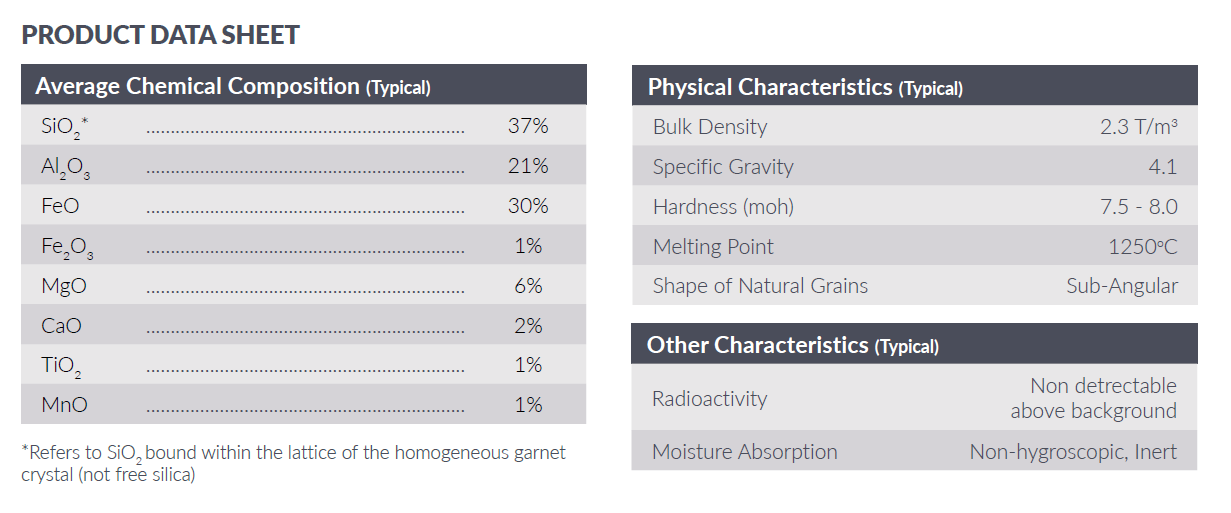
As per GMA’s SDS, a bag of GMA Garnet™ has greater than 96% of almandine garnet and less than 0.1% of free crystalline silica (refer to diagram below).
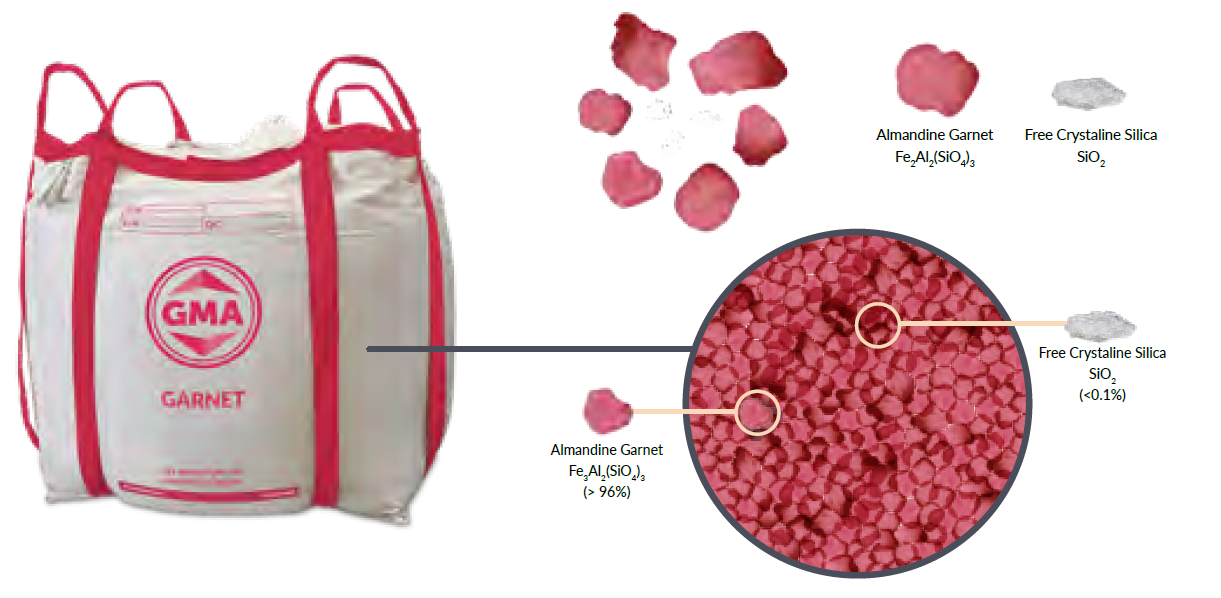
SAFETY DATA SHEET : Composition / Information on ingredients
This material is a natural mixture of almadine garnet and other trace minerals.

What does this mean for your abrasive blasting operations?
Safework Australia recently released an updated Code of Practice in July 2020. The latest code provides practical guidance to the Person Conducting Business Undertaking (PCBU) on ways to manage health and safety risks associated with abrasive blasting6. The code was implemented to have businesses’ monitor its respirable dust so that it complies with the latest WES 0.05mg/m3 free crystalline silica requirements.

Responsibilities and safety duties required
Duty holders who have a role in managing the risks of abrasive blasting include:
- Persons conducting a business or undertaking
- Designers, manufacturers, importers, suppliers, and contractors/installers of plant, substances or structures
- Company directors and officers
- Workers have a duty of care for their own safety as well as not have adversely affect the health and safety of others
- Other persons and visitors must take reasonable care.

Not all garnets are equal
Consistency issues with other garnet suppliers
Unlike GMA, other garnet traders’ (particularly the Indian and Chinese) manufacturing processes, sourcing controls vary and are limited. Their garnets are pooled and blended from multiple inconsistent sources. The volatility in product consistency and quality becomes a key risk for businesses that require consistent supply.
Security of supply – fully integrated global business
GMA is the only company that owns the supply chain from the mine to the customer. Being a fully integrated global business, we are able to maintain an uninterrupted high-quality, consistent garnet supply to our customers.
We own and operate mines in Australia and the USA, and have long term agreements with a significant supply source in South Africa. These operations provide us with an ample, consistent, and secure garnet supply.

“In the 1970’s GMA pioneered the use of garnet minerals as a natural industrial abrasive.”
Our Supply Chain
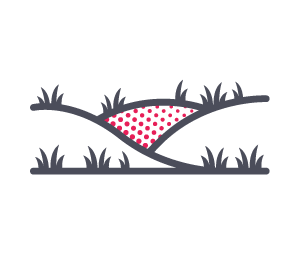
Restoration
The tailings sands are returned to the mined area which is rehabilitated to its former environment.

Mining
Garnet rich sand is mined and transported to our 24/7 ‘Wet’ plant for processing.

Wet Plant
Water and centrifugal forces are used to separate the garnet from lighter waste minerals, leaving a high quality garnet concerntrate.

Final Quality Control
Final laboratory testing ensures the highest quality standards are met.

Dry Plant
Magnetic separators remove impurities and the pure garnet is screened and graded into the correct size particles.

Quality Control
The concentrate is sample tested in the laboratory to ensure consistent product quality.

Packaging
GMA Garnet is packaged into one-tonne or two-tonne bulk bags and 25kg paper bags.

Distribution
GMA Products are distributed in 80 countries via our warehouses and over 100 distributor outlets worldwide.

Customer Service
Dedicated sales team assist customers in selecting the best products and logistics arrangements.

Technical Support
Our experts support customers in solving technical challenges and maximizing productivity and performance of their projects.
Consistent quality that performs
GMA Garnet™ is not only intrinsically safe to use, its consistent sizing and quality produce reliable abrasive blasting performance every time. We systematically test and analyse our garnet across 12 key areas, ensuring that GMA Garnet™ meets the highest industry, safety, and quality standards. The entire process is certified under various international quality standards.
The product supplied to customers will be from GMA’s Australian mining operations, which has been assessed and is currently certified as meeting the requirements of:
- ISO 9001:2015 (Quality Management Systems)
- ISO 14001:2015 (Environmental Management Systems)
- ISO 45001:2018 (Occupational Health & Safety Management Systems)
You can be assured that every bag of GMA Garnet™ delivered to you will contain at least 96% garnet or more. It is a stark contrast compared to other low-quality operations around the world, where every bag contains 15-25% trash material. Not only will this impact performance but also coating life.
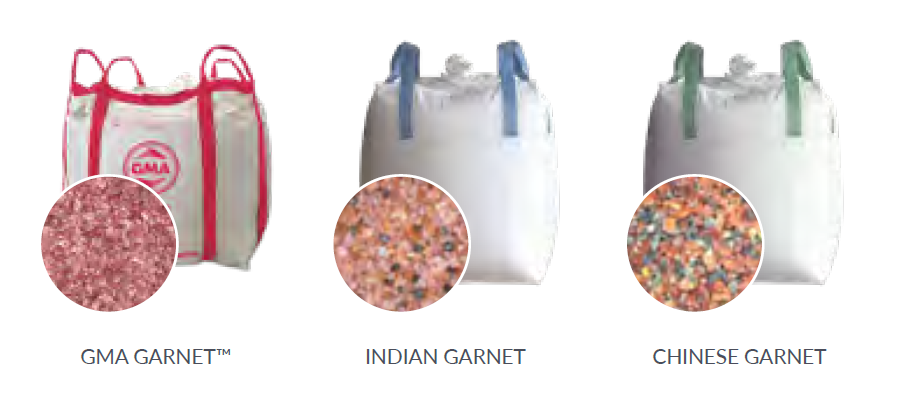

12
key testing areas to ensure the highest quality standard.
World class sampling process
Samples are taken every two hours to ensure GMA’s processed garnet abrasives are of the highest standards. For 35 years, we have developed advanced production monitoring and processes that are embedded into our operations.
Product analysis is regularly conducted to ensure that products meet the highest industry and product quality standards. The analytical information from these results is used to ensure the accuracy of the PDS and SDS of GMA products. GMA undertakes rigorous internal and external product testing before our products are packaged and dispatched to customers (refer to the image below).

GMA GARNET™ PRODUCT MONITORING AND TESTING
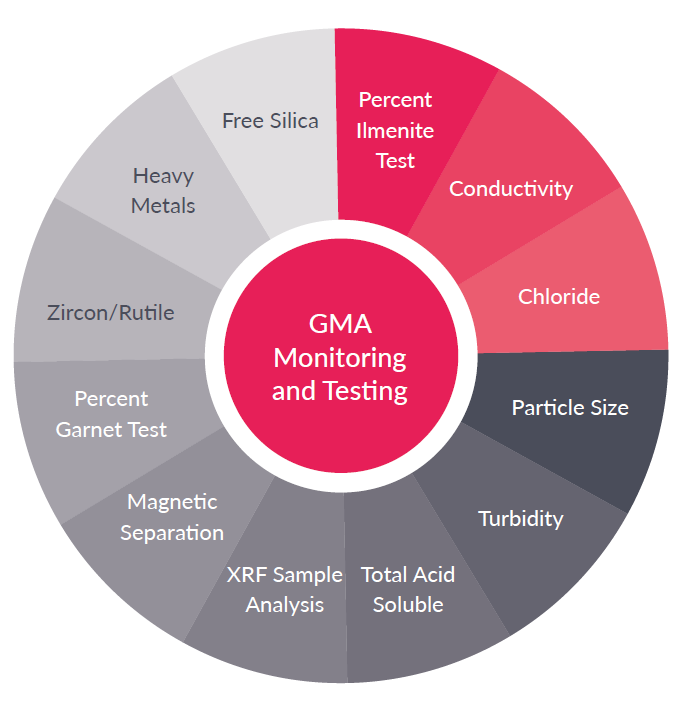

Independent reports are produced regularly to ensure product accuracy.
To ensure accuracy, third party product testing reports are also available upon request.
Tip: Request for third party reports to ensure product safety and integrity.
The preferred industry choice
GMA has been supplying high-quality garnet abrasives to the global markets for over 35 years.
We offer a complete range of garnet abrasives for any surface preparation requirement from removing resistant coatings and heavy rust, to fast millscale removal and specialty coating requirements.
GMA Garnet™ is approved by leading paint manufacturers and is the preferred abrasive among global oil & gas companies, full-service shipyards and international fabricators.
Find out more about how we can work together to keep your worksite and workers safe when using GMA Garnet™ abrasives.
 My Account
My Account

